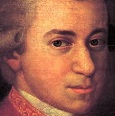Wolfgang Amadeus Mozart
b Salzburg, January 27, 1756; d Vienna, December 5, 1791
Child wonder, virtuoso performer and prolific creative artist, Mozart is the first composer whose operas have never been out of repertory. His prodigious talents were apparent very early in his life; by the age of four he could reproduce on the keyboard a melody played to him, at five he could play the violin with perfect intonation, and at six he composed his first minuet.
A musician himself, Wolfgang’s father, Leopold, immediately saw the potential of his son’s talents. With the mixed motives of religious piety and making a tidy profit, Leopold embarked on a series of concert tours showing off the child’s extraordinary talents. Often playing with his sister Maria Anna (“Nannerl”), herself an accomplished musician, young Wolfgang charmed the royal courts of Europe, from those of Austrian Empress Maria Theresa, French king Louis xv and English king George iii, to the lesser principalities of Germany and Italy.
As Mozart grew older, his concert tours turned into a search for permanent employment, but this proved exceedingly difficult for a German musician in a market dominated by Italian composers. Although many of his early operas were commissioned by Milanese and Munich nobles (Mitridate, Ascanio in Alba, Lucio Silla, La finta giardiniera), he could not rise beyond Konzertmeister of the Salzburg archbishopric. When the new prince archbishop, Count Hieronymus Colloredo, was appointed in 1771, Mozart also found he was released for guest engagements with less frequency. Though his position improved and a generous salary was offered, the composer felt the Salzburg musical scene was stifling for a man of his enormous talent and creativity.
Things came to a head in 1781 immediately after the successful premiere of Mozart’s first mature work, Idomeneo, in Munich. The archbishop, then visiting Vienna, insisted the composer join him there. Never did Mozart better understand his position in the household than during that sojourn, when he was seated at the dinner table below the prince’s personal valets and just above the cooks. He requested to be permanently discharged from his duties, and after several heated discussions his petition was granted, punctuated by a parting kick in the pants.
Now completely on his own for the first time, Mozart embarked on several happy years. He married Constanze Weber, sister to his childhood sweetheart Aloysia, and premiered a new work, Die Entführung aus dem Serail (The Abduction from the Seraglio), at the Burgtheater. Mozart also gave concerts around Vienna, presenting a number of new piano concertos and symphonies. His chief concern was to procure a position at the imperial court. A small commission came his way from the emperor for a one-act comedy, Der Schauspieldirektor (The Impresario), given in the same evening as Antonio Salieri’s Prima la musica, e poi le parole (First the music, then the words), to celebrate the visit of the emperor’s sister, Marie Christine, and her husband, joint rulers of the Austrian Netherlands.
The Marriage of Figaro, Mozart’s first true masterpiece for the imperial court, premiered at the Burgtheater in 1786 and went on to Prague the following year where it was a huge success. Don Giovanni premiered in Prague in 1787 to great acclaim, but its Vienna premiere in 1788 was coolly received. By this time, Mozart had received a minor Imperial posting, Kammermusicus, which required him to write dances for state functions. The position was hardly worthy of his skills and generated only a modest income, a weighty concern now that debts had begun to mount. Joseph ii commissioned another opera from Mozart, Così fan tutte, which premiered January 26, 1790. The emperor was too ill to attend the opening and died the following month. His brother, Leopold ii, assumed leadership, and Mozart hoped to be appointed Kapellmeister – instead he merely received a continuance of his previous position.
Crisis hit in 1791. Constanze’s medical treatments at Baden and the birth of a second child pushed their finances to a critical point. Mozart’s friend and fellow Freemason, the impresario Emanuel Schikaneder, suggested he try his luck with the suburban audiences at his Theater auf der Wieden. Composition of The Magic Flute began early that summer but had to be halted when two generous commissions came his way: a requiem for an anonymous patron (who hoped to pass it off as his own composition), and an opera seria to celebrate the new emperor’s coronation as King of Bohemia. La clemenza di Tito premiered September 6, and The Magic Flute was completed in time to open September 30. The Requiem, however, remained unfinished, and as Mozart’s health began to fail, the composer feared he was writing his own death mass. In December Mozart died at the age of 35 and was given a simple funeral by his impoverished widow, then buried in a mass grave on the outskirts of Vienna.
